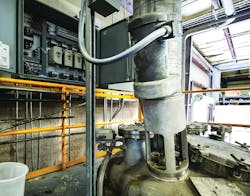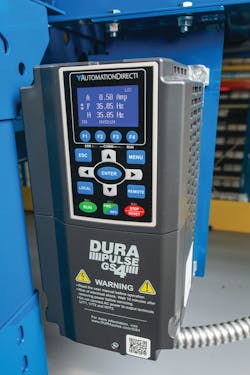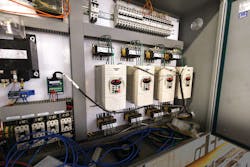Beyond process control with VFDs
Anyone remember working with AC motor variable speed drives circa 1985? Something like a 5 HP drive might be situated in a freestanding enclosure with dual doors. Inside would be six individual gate driver boards, with associated ribbon cables and stranded wiring. Numerous potentiometers and rotary switches were used to configure the equipment, and these could often pose a troubleshooting nightmare.
Early drives like these had rudimentary features such as start and stop buttons, perhaps some form of acceleration and deceleration ramps, current control and maybe some basic error annunciation. And that was about it. But for all these limitations, an AC drive might still have been preferable compared to the alternative of achieving variable speed through some other electrical or mechanical means.
Today’s AC drives, sometimes called inverters but also commonly called variable frequency drives (VFDs), are commonplace when motor speed must be adjusted to meet the load. Consumer-grade appliances, commercial HVAC systems and industrial equipment all employ VFDs, sometimes almost as a default. Even when the application does not demand variable speed control, VFDs offer other operating benefits, monitoring capabilities and energy-saving opportunities.
This article looks at the past, present and near future evolution of VFD technologies, and it shows why designers should always consider applying VFDs for new processing machines and systems, and for many other types of applications.
VFDs can go most anywhere
Much has changed with VFD technology over the past decades. Today’s 5 HP VFD physically fits into a space of less than one cubic foot. The shrinking size of VFDs is largely due to semiconductor advances, with current densities exceeding 25 amps per square centimeter. The reduced footprint makes it possible to use these advanced power devices to control output energy to prime movers (motors) in more applications (Figure 1).
For smaller motor loads of 1HP or less, there are VFDs that literally fit in the palm of one’s hand. Design ratings for VFDs enable them to work in nearly any environment, including sub-zero temperatures down to -40°F. Advances in heat dissipation permit operation in ambient temperatures up to 50°C or better, which can be a more challenging condition for VFDs than extreme cold.
Enclosed VFDs are now available with NEMA 12, NEMA 3R and/or NEMA 4X and IP66 ratings, meaning they can be used in downpouring rain and washdown conditions. Some VFDs are coming to market with their own enclosed casings that are NEMA 4X outdoor-rated, right out of the box.
While VFDs must offer the right physical arrangement so they can be installed near motors in any field situation, the real VFD developments over the years have been in the brains department.
VFDs get smart
Over the years, VFD configuration was originally performed using switches and knobs and eventually progressed to various types of specialized on-board and removable/replaceable human machine interfaces. These keypads offered upload/download capabilities, on-board memory, were hot-pluggable and even compatible with QR codes for convenience (Figure 2). These were great advances, but even those methods took some time to navigate through ever-increasing quantities of parameters and functions.
Today’s VFDs have graduated to the use of convenient HMI methods already available to everyone: PCs and mobile devices. Often, the software and mobile apps are free. Instead of only cryptic parameter codes and difficult-to-enter values, modern VFD HMIs generally provide a much more graphical and simpler user experience.
Via wired or wireless networking connections, users can easily interact with VFDs to:
- Configure functions
- Adjust control, operating and drive physics parameters
- Upload/download settings
- Monitor operation
- Adjust tracking and tuning
- Access advanced scope functions
- Perform firmware downloads
Beyond basic speed control abilities, another area of advancement involves the significant logic execution and I/O connectivity available right onboard the VFD. For many years, programmable logic controllers (PLCs) have been used in concert with VFDs to perform control and monitoring — first with hardwired I/O signals, and eventually with networked industrial communication protocols.
Those approaches are still valid, but now many VFDs have PLC-like programing and control capabilities built right in. This becomes relevant when a processing unit must continue to run safely in a local manner (such as operating an agitator to prevent product from solidifying, while continuing to monitor a hatch interlock), even if the supervisory control system or network is not available. VFDs can also be employed for local PID control in a similar manner, making local operations more robust, and in some situations VFDs can control an entire small machine process, such as a pumping station.
Complemented by brawn
VFD brains have also been complemented by electrical brawn through power handling and safety features. Advanced new motor designs are making it possible to achieve improved levels of transmitted power, efficiency and load control accuracy. These include internal permanent magnet, surface permanent magnet motors with active magnetic bearings, pancake traction motors and synchronous reluctance motors, some with advanced cooling systems. As process designers incorporate these motor types to optimize their designs and meet their demands, compatible VFDs to drive them are needed.
Another VFD advancement involves safety measures. Because VFDs often drive equipment that may present a hazard to workers, it is important to interlock the VFD with suitable safety circuit devices such as emergency stop buttons, guard switches, safety curtains and more. A conventional safety interlock circuit cuts off power to disable the VFD, but this method has limitations and can be difficult and expensive to implement.
Modern VFDs incorporate safe torque off (STO) and other industry-standard safe control methods such as SS1 or SS2 safe stop modes, safe brake control (SBC), safely limited speed (SLS), safe direction (SDI) and safely limited acceleration (SLA). Circuitry for these functions is qualified by a certification agency to meet requirements. When safety devices are wired to a VFD’s STO inputs and a hazardous condition is detected, the drive will quickly remove power from the outputs via redundant means, with the driven motor positively de-energized and coasting to a stop.
Of course, there may be design considerations and situations where other equipment-stopping methods should be used. But in many cases, the availability of STO and other safe control functions is another reason to design new process equipment or upgrade existing installations, using modern VFDs.
The connected VFD
Many process plants have taken advantage of VFD networking capabilities to greatly reduce field wiring and increase the amount of data transfer and control options. Most VFDs now support various Ethernet protocols, or other industrial fieldbuses, for this purpose (Figure 3).
Fiber optics are immune to electrical noise and provide much higher performance than copper networking, and new wireless broadband networking options are becoming available and may actually eliminate physical network wiring or fiber while delivering high-performance, real-time control and time-sensitive data transmission. Methods such as fiber optic wavelength-division multiplexing (WDM) and wireless 5G are making high-speed, high-bandwidth connections more available than ever.
VFDs now incorporate high-speed and redundant-capable ways to flawlessly support the fastest motion control applications and provide accurate data gathering, using protocols such as real time protocol (RTP), parallel redundancy protocol (PRP) and high-availability seamless redundancy (HSR). High-speed manufacturing processes for printing, paper and steel, as well as critical processing for pharmaceutical and food and beverage, demand these reliable integration methods.
Years ago, users would only be concerned with using a VFD to run a motor at various speeds as commanded. Now that even entry-level VFDs have extensive processing, electrical and connectivity options, they are becoming a crucial building block for digital transformation and the industrial internet of things (IIoT).
Because VFDs are usually located close to the operating edge, they can be used to gather all sorts of extended information. This includes voltage, current and power information from the drive — along with motor and drive diagnostics, and performance data. The status of I/O points connected to the drive, such as safety or other interlock devices, can also be reported.
The confluence of processing, power and communications advancements are enabling reliable control and data accessibility like never before. Even if these added features are not used immediately, choosing a VFD with these capabilities when designing equipment is a form of futureproofing, or at least making the system upgrade-ready.
Applications abound
Some of the best applications for an upgrade to a VFD are pumps and fans commonly used in processing industries because significant energy savings may be realized by running the equipment at less than full speed, if the process allows for it. Material conveying and packaging systems also make heavy use of VFDs to adjust equipment speeds based on operating conditions. In many cases, the smooth speed ramping of VFDs prevents the type of damage to product and mechanical systems that can occur when single-speed motors are immediately started at full speed.
Other applications can use VFDs to promote an increased standard of living and a cleaner environment:
- Energy production and distribution
- Desalinization
- Freshwater treatment and distribution
- Wastewater treatment
- Agricultural water and nutrient transport
- Food and beverage
- Electric vehicles
Using VFDs for these types of projects makes them practical today and will also provide the IIoT capability and deep data needed to analyze and optimize operating performance.
Future developments
Like many other solid-state technologies, VFDs have followed Moore’s Law to some extent. Although the VFDs available today are quite good, even better versions will continue to be developed. Smaller and faster devices, with ever more processing power and more user-friendly interfaces, will be an increasing trend. Perhaps concepts such as holographic displays and artificial intelligence for providing operational and user assistance, which are futuristic by today’s standards, will be common soon.
But that doesn’t mean process industry users and designers should wait around for the next great thing in VFDs. The VFDs available today offer high performance and significant energy savings. More importantly, they pave the way for end users to begin digital transformation and IIoT initiatives within their processing plants.
Bryan Sisler is the product manager for drives and motors at AutomationDirect. He has been involved in the automation and the electrical/electronic field for 35 years. Sisler started his career in the U.S. Army in cryptographic equipment, and then moved into production and electrical maintenance management, and then product management. He has been involved in the automation industry for the last 28 years, most of them specializing in drives, motors and communications technologies at a variety of large industrial manufacturers and distributors.


